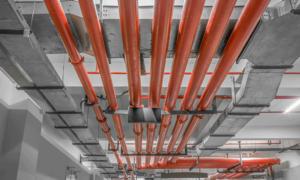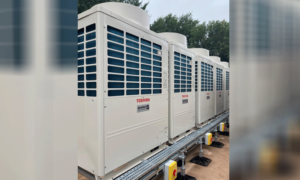Electric controlled devices are vital in an HVAC unit to monitor and control the overall health of the unit. These devices provide ON/OFF option or a two-position control to the unit. Low voltage electrical controls are most common n residential and small commercial applications. This voltage signal is controlled by thermostats, and can open gas solenoid valves, energise oil burners or solenoid valves on the DX cooling, control electric heat, operate two position valves and dampers, or turn on-off fans and pumps. A relay or contactor is used to switch line voltage equipment with the low voltage control signal.
The advantage of an electric system is that it eliminates the personnel safety and fire risk associated with line voltage, and allows these control wires to be installed by a non-electrician without requiring conduit and other safety measures. However, these systems are generally limited to providing on/off control only: they cannot operate at half capacity.
Pneumatic Systems
Compressed air with an input pressure can be regulated by thermostats and humidistat. By varying the discharge air pressure from these devices, the signal can be used directly to open valves, close dampers, and energise other equipment. The copper or plastic tubing carries the control signals around the building, which is relatively inexpensive. The pneumatic system is very durable, safe in hazardous areas where electrical sparks must be avoided, and most importantly, capable of modulation or operation at part load condition.
Pneumatic controls use clean, dry and oil free compressed air, both as the control signal medium and to drive the valve stem with the use of diaphragms. It is important that dirt, moisture and oil are absent from the compressed air supply. Instrument quality of compressed air is more suitable for controls rather than industrial quality and requires drying to a dew-point low enough to satisfy the application. The main disadvantages are less reliability and more noise when compared to electronic systems.
Types of Sensors
Sensors are an extremely important part of the control system and can be a weak link in the chain of control. A sensor-transducer assembly is called a transmitter. Some electronic sensors use an inherent attribute of their material (e.g., wire resistance) to provide a signal and can be directly connected to the electronic controller. Some sensors may measure other temperatures, time of day, electrical demand condition, or other variables that affect the controller logic. Other sensors input data that influence the control logic or safety including airflow, water flow, current, fire, smoke, or high/low temperature limits.
Electronic Sensors
The electronic temperature sensors are classified in following categories:
Resistance Temperature Devices (RTD):
Resistance Temperature Detectors (RTD) operates on the principle that the electrical resistance of a metal changes predictably and in an essentially linear and repeatable manner with changes in temperature. The resistance of the element at a base temperature is proportional to the length of the element and the inverse of the cross sectional area.
Common materials used in RTD sensors are BALCO wire, Copper, Platinum, 10K Thermistors, and 30K Thermistors.
- BALCO – A sensor constructed using a BALCO wire is an annealed resistance alloy with a nominal composition of 70 percent nickel and 30 percent iron. A BALCO 500-ohm resistance element provides a relatively linear resistance variation from -40 to 250°F. The sensor is a low-mass device and responds quickly to changes in temperature. When 1000 ohms is measured across the BALCO element, the temperature is approximately 70°F. As the temperature increases, the resistance changes 2.2 ohms per 1°F.
- Platinum – RTD sensors using platinum material exhibit linear response and stability over time. In some applications a short length of wire is used to provide a nominal resistance of 100 ohms A platinum film sensor on an insulating base provides high resistance to the tune of 1000 ohms at 74°F. With this high resistance, the sensor is relatively immune to self-heating and responds quickly to changes in temperature. RTD elements of this type are common.
However, having linear resistance with temperature, good stability, and wide range of operating temperature, interchangeable over wide temperature range is one of the advantages. But a minor resistance change with temperature may decrease the response time, subject to self heating.
For more details, visit,
www.cedengineering.com
AH Bhatia
Email: info@cedengineering.com
Cookie Consent
We use cookies to personalize your experience. By continuing to visit this website you agree to our Terms & Conditions, Privacy Policy and Cookie Policy.















